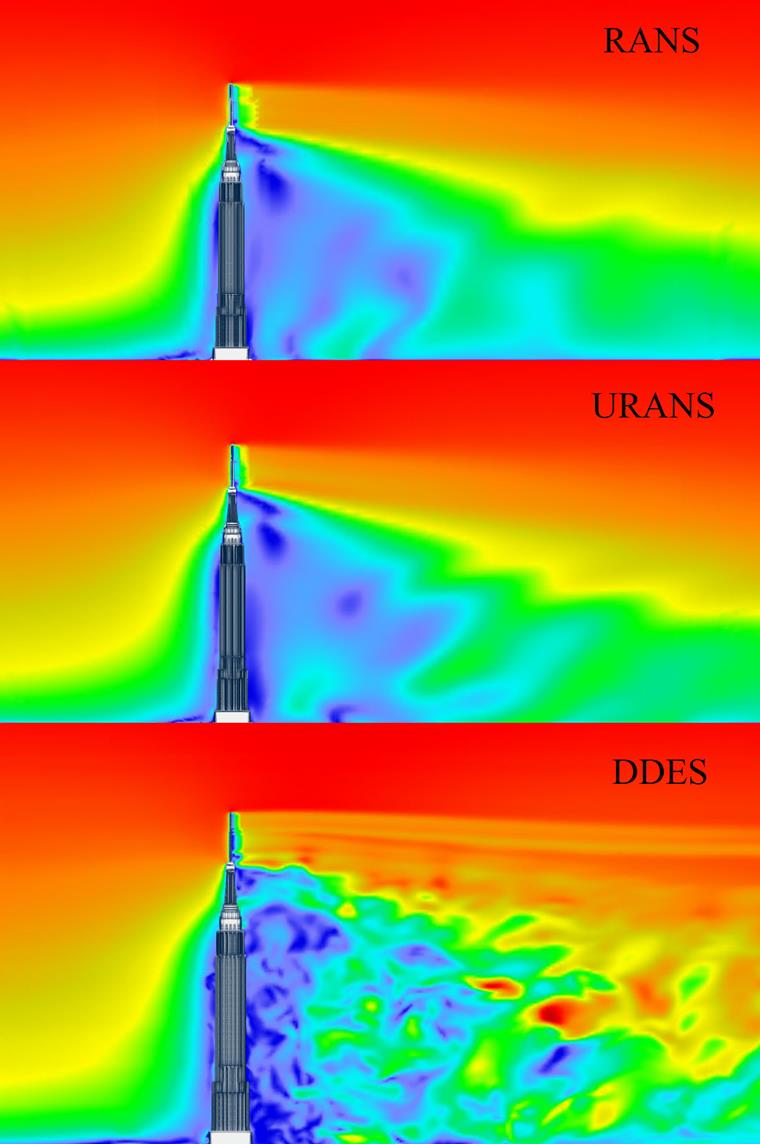Die Turbulenzmodellierung ist ein wichtiger Aspekt der numerischen Strömungsmechanik (CFD), die das Verhalten turbulenter Strömungen vorhersagen soll. Turbulenzmodelle sind für die Entwicklung effizienter und sicherer technischer Anwendungen unerlässlich, wie z.B. für die Interaktion zwischen Wind und Bauwerken im Rahmen der statischen Berechnung und Bemessung. Unter den verschiedenen Ansätzen zur Turbulenzmodellierung sind drei Modelle besonders beliebt: das Reynolds-Averaged Navier-Stokes-Modell (RANS), das Unsteady Reynolds-Averaged Navier-Stokes-Modell (URANS) und das Delayed Detached Eddy Simulation-Modell (DDES). Jedes Modell hat seine eigenen Besonderheiten und Anwendungsbereiche.
RANS (Reynolds-Averaged Navier-Stokes)
Der RANS-Ansatz ist eine der gängigsten Methoden zur Turbulenzmodellierung. Dabei werden die Navier-Stokes-Gleichungen über die Zeit gemittelt, wodurch die Turbulenzschwankungen effektiv geglättet werden, um eine stationäre Lösung zu erhalten. Diese Methode vereinfacht die Rechenanforderungen erheblich und ist besonders nützlich für Anwendungen, bei denen die Strömung stationär oder leicht instationär ist. RANS-Modelle werden aufgrund ihrer Robustheit und geringen Rechenkosten häufig in industriellen Anwendungen eingesetzt. Allerdings können sie bei der Vorhersage komplexer Strömungen mit erheblicher Ablösung oder starker Instabilität weniger genau sein.
URANS (Unsteady Reynolds-Averaged Navier-Stokes)
URANS erweitert den RANS-Ansatz, indem es zeitabhängige Änderungen im Strömungsfeld berücksichtigt und so instationäre Phänomene erfassen kann. Es nutzt weiterhin die Reynolds-Mittelung der Navier-Stokes-Gleichungen, mittelt jedoch die Strömung nicht so streng wie RANS. Das bedeutet, dass URANS großräumige, instationäre Strömungseigenschaften und oszillierende Verhaltensweisen modellieren kann, die in vielen praktischen technischen Systemen typisch sind, wie beispielsweise Wirbelablösung an Gebäudeecken. Während URANS gegenüber RANS hinsichtlich der Erfassung von Instationarität verbessert ist, verwendet es dennoch Wirbelviskositätsmodelle, die feinere turbulente Strukturen möglicherweise nicht ausreichend auflösen.
DDES (Delayed Detached Eddy Simulation)
DDES ist ein hybrider Ansatz, der RANS- und Large Eddy Simulation (LES)-Methoden kombiniert. In Strömungsbereichen, in denen die Grenzschicht anhaftet, verhält sich DDES wie ein RANS-Modell und bietet somit eine hohe Recheneffizienz. In Bereichen, in denen sich die Strömung ablöst und größere turbulente Strukturen dominieren, wechselt DDES in einen LES-Modus, der diese Strukturen genauer auflöst. Diese Methode ist besonders nützlich bei komplexen Strömungen mit Strömungsablösung, Wiederanlegen und Nachlaufbereichen, wie z.B. bei Gebäudekanten und -ecken. DDES bietet ein gutes Gleichgewicht zwischen Rechenaufwand und Genauigkeit, insbesondere bei der Simulation von Strömungen mit hoher Reynolds-Zahl und signifikanten instationären und abgelösten Bereichen.
Fazit
Die Wahl des richtigen Turbulenzmodells hängt weitgehend von den spezifischen Anforderungen des jeweiligen Problems ab, darunter die Strömungseigenschaften, die Genauigkeitsanforderungen und die verfügbaren Rechenressourcen. RANS-Modelle eignen sich für einfachere, stationäre Strömungen, während URANS eine bessere Handhabung instationärer Phänomene ermöglicht. DDES ist zwar rechenintensiver als RANS oder URANS, bietet jedoch eine überlegene Genauigkeit in Fällen mit komplexen, instationären, abgelösten Strömungen. Jedes dieser Modelle hat wesentlich zu den Fortschritten in der Strömungssimulation beigetragen und Ingenieure und Forscher bei der Entwicklung effektiverer und effizienterer technologischer Lösungen unterstützt.
